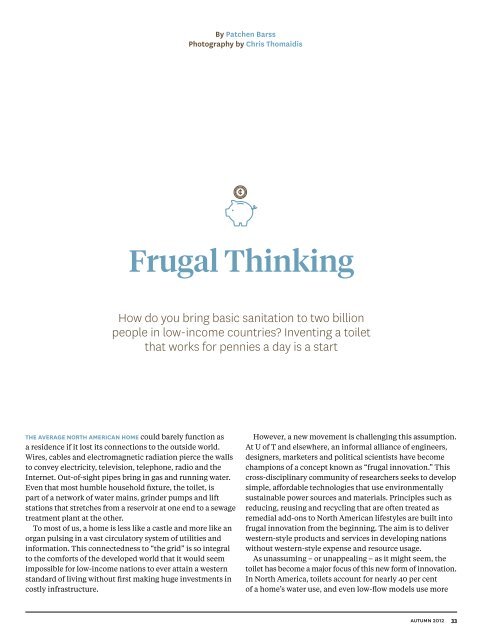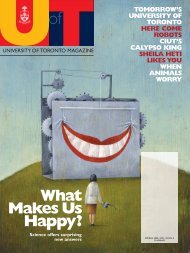8 MB - University of Toronto Magazine
8 MB - University of Toronto Magazine
8 MB - University of Toronto Magazine
- No tags were found...
You also want an ePaper? Increase the reach of your titles
YUMPU automatically turns print PDFs into web optimized ePapers that Google loves.
By Patchen Barss<br />
Photography by Chris Thomaidis<br />
Frugal Thinking<br />
How do you bring basic sanitation to two billion<br />
people in low-income countries Inventing a toilet<br />
that works for pennies a day is a start<br />
The average North American home could barely function as<br />
a residence if it lost its connections to the outside world.<br />
Wires, cables and electromagnetic radiation pierce the walls<br />
to convey electricity, television, telephone, radio and the<br />
Internet. Out-<strong>of</strong>-sight pipes bring in gas and running water.<br />
Even that most humble household fixture, the toilet, is<br />
part <strong>of</strong> a network <strong>of</strong> water mains, grinder pumps and lift<br />
stations that stretches from a reservoir at one end to a sewage<br />
treatment plant at the other.<br />
To most <strong>of</strong> us, a home is less like a castle and more like an<br />
organ pulsing in a vast circulatory system <strong>of</strong> utilities and<br />
information. This connectedness to “the grid” is so integral<br />
to the comforts <strong>of</strong> the developed world that it would seem<br />
impossible for low-income nations to ever attain a western<br />
standard <strong>of</strong> living without first making huge investments in<br />
costly infrastructure.<br />
However, a new movement is challenging this assumption.<br />
At U <strong>of</strong> T and elsewhere, an informal alliance <strong>of</strong> engineers,<br />
designers, marketers and political scientists have become<br />
champions <strong>of</strong> a concept known as “frugal innovation.” This<br />
cross-disciplinary community <strong>of</strong> researchers seeks to develop<br />
simple, affordable technologies that use environmentally<br />
sustainable power sources and materials. Principles such as<br />
reducing, reusing and recycling that are <strong>of</strong>ten treated as<br />
remedial add-ons to North American lifestyles are built into<br />
frugal innovation from the beginning. The aim is to deliver<br />
western-style products and services in developing nations<br />
without western-style expense and resource usage.<br />
As unassuming – or unappealing – as it might seem, the<br />
toilet has become a major focus <strong>of</strong> this new form <strong>of</strong> innovation.<br />
In North America, toilets account for nearly 40 per cent<br />
<strong>of</strong> a home’s water use, and even low-flow models use more<br />
Autumn 2012 33
















